http://www.dreamcatcherstables.org

Dream Catcher Stables, Inc
20907 Birnamwood Blvd.
Humble, TX 77338
Mailing Address:
P.O. Box 1454
Spring, TX 77383
Phone: 281-216-3494 MAKE AN INQUIRY
View our WEBSITE
EIN: 76-0618111Founded: 1999
View our PHOTO GALLERY
Profile Last Updated January 25, 2024Public Charity
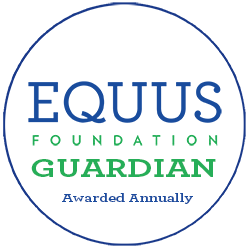
The Guardian Seal of Transparency is awarded annually to recognize an organization's commitment to transparency and accountability by their willingness to make comprehensive data about their programs, horse care practices, and governance available for public scrutiny. The Guardian Seal of Transparency is NOT an endorsement.
Last Updated: July 10, 2023
Dream Catcher Stables, Inc has not attained the Guardian designation for 2024.
MISSION & PROGRAMS
Mission:To provide a place in perpetuity where people with disabilities can be successful, equal, and capable, growing to their maximum life's potential through interaction with horses in a positive environment.
Our organization conducts Equine Assisted Services in accordance with the EQUUS Foundation Guidelines on Qualifications of Organizations Conducting Equine Assisted Services (EAS).
Our organization provides community outreach and/or public education programs involving horses.
Our organization is directly responsible for the care and shelter of equines involved in our programs.
100% of our total programs and services are equine-related.
Our organization does not CURRENTLY use satellite, overflow, foster, and/or outreach facilities.
Equine Assisted Services (EAS):
Our organization provides the following Equine Assisted Services (EAS):
Therapeutic Mounted Services
Therapeutic Unmounted Services
Equine-Assisted Learning involving Academic Learning
1: Total number of Equine Assisted Service Providers at Dream Catcher Stables
1. Sanna Roling
FACILITY PARTICIPATION:
Dream Catcher Stables
RELATIONSHIP: Volunteer
SERVICES PROVIDED:
Therapeutic Mounted Services
Therapeutic Unmounted Services
Equine-Assisted Learning involving Academic Learning
DEGREES, LICENSES AND/OR CERTIFICATIONS
PATH Intl CTRI, ESMHL
CHA Level 3 English Level 2 Western
Retired Special educator currently certified in the State of Texas.
Special Olympics Coach Level 3 Equestrian and Unified
Life member CHA, AQHA, HLS&R
Certified in First Aid/CPR, and AED through the Red Cross
Overview of our programs involved with providing EAS to individuals with special needs:
While we are part of the Therapeutic Riding Industry, Dream Catcher Stables Inc works entirely in the recreation, education, sport sector of that industry. We do not have therapists in our program and do NOT write medical goals. What we do is teach people with disabilities to ride and care for horses to the fullest extent of their ability. Individual goals are all of a horsemanship nature. Each family comes and shares with us their needs and hopes.
Because we teach horsemanship the disability categories are clustered in our program:
Physical includes arthritis, epilepsy, joint abnormalities, multiple sclerosis, paralysis, physical disabilities, spinal cord injury, traumatic brain injury, amputation, cystic fibrosis, head Trauma/Brain Injury, Muscular dystrophy, orthopedic issues, Spina bifida, and stroke.
Speech includes language impairment and speech impairment.
Autism, Deaf or those with hearing loss, and Visual Impairment stand alone.
Cognitive includes cognitive disabilities, development delay or disability, Down Syndrome, intellectual disability, and learning disabilities.
Behavioral includes ADD, behavioral disabilities, emotional disabilities, mental health disabilities, PDD, and PTSD.
How we teach individual lessons depends on the capabilities of the rider and their attitude and physical situation each day.
Riders prone to seizures have a horse handler and side-walker with them at all times. These volunteers may move a distance away from the horse or may actually be in interactive positions. In addition to maintaining safety and assisting in the teaching process the horse handler is responsible for controlling the horse during a seizure and the side-walker is responsible for creating a safe situation for the rider having the seizure.
Riders with physical disabilities may have special reins, saddles, or if their legs do not function a crop/dressage whip to compensate.
Riders with behavioral challenges are especially prompted to be kind to the horse. Hitting, biting, kicking at volunteers or their horse is not tolerated. Such an offense is met with end of lesson, discussion of good actions, reason the lesson is over, and what to do to come again.
Visually impaired riders may have volunteers strategically positioned to provide specific one word directions or sounds for the rider to succeed independently.
Riders with hearing challenges are paired with a volunteer whose voice they can hear easily. Also stop and go signs, an interpreter, or other adaptations may be used to provide communication.
Riders on the autism spectrum are individuals with quite a varied range of abilities. Some are savants, others aggressive, still others have difficulty with speech, balance, seizures or melt downs, intellectual abilities and more. For the novice, thinking of a kaleidoscope and understanding that a person with autism initially sees the world as though through a kaleidoscope, understanding how they perceive the world becomes more meaningful. The structure of a riding lesson with the ever changing patterns within that lesson helps the person with autism to understand and accept differences and thus the real world.
Teaching classical riding we emphasize:
1) Position which affects balance, joints, muscle and bone alignment.
2) Control using the four natural aids – legs, seat, voice, and hands - improving attention, simultaneous multi-functioning, and reasoning.
3) Consistent movement of the horse which activates the autonomic nervous system creating physical responses in the rider’s body without conscious thinking.
Improvements include but are not limited to the ability to walk, talk, think and balance.
All riders are taught voice, seat, leg and rein commands necessary to control their horse at all times. Horse handlers are prompted to allow the rider to learn by giving the rider the opportunity to fail in order to succeed. Consequently if the instructor says “Susy, walk your horse” -- at a stand still, Suzy will be prompted to say “walk on”, squeeze with both legs, sit tall, look between the horse’s ears at the tall tree, and put your hands forward and down. As soon as the rider makes or attempts any of those commands, the horse handler will prompt the horse to walk on. Thus Suzy will experience the reward for effort. For cognitive students the process of actually completing one or more of the set of commands may take a while. Each and every command is encouraged and when executed properly is rewarded with high fives, kind words, and happy smiles.
The first lesson, each individual is assigned two side-walkers and a horse handler. As they exhibit their actual capabilities the side-walkers and horse handler are removed. Often removal of the side-walkers occurs just a few steps into the first lesson. Once the rider demonstrates consistent control of the horse at a walk, the horse handler will remove the lead rope and walk nearby as long as necessary for safety.
The true “heart” of the Dream Catcher Stables program is our Positive Reinforcement piece:
1)Rider must attend school, except when they are ill or have an excusable appointment.
2)Rider must try to behave at school.
3)Rider must try to do their school work.
4)Rider must take homework home to parent(s)and back to the teacher.
5)At home rider must try to behave.
6)At home rider must try to help their family.
To the extent they try they get to ride. To the extent they do NOT try we have other things for them to do instead of riding the horse. This positive reinforcement piece is extremely successful and parents have learned how to manipulate it for greater success year round.
Community Outreach and/or Public Education:
Once again our program for adjudicated youth to complete their community service hours is open. Youth who get tickets at school and are assigned community service may complete facility chores including picking up trash along our fence line, making repairs supervised by one or more volunteers, and sometimes helping with program by cleaning stalls, grooming horses, or acting as side-walkers for an athlete with poor balance.
Results of our 21-22 pilot program providing pre-vocational/vocational training for a class of 19-22 year old students with disabilities during the school day each week were very successful. Their work included horse behavior, grooming, stall cleaning, haltering and leading, cleaning tack, repairing/constructing fences, horsemanship theory, and a one time riding lesson. Interwoven each week is discussion that includes topics such as available jobs in the horse industry, essential knowledge for those jobs, creating a resume, what recruiters/HR might look for and where, and more. AS a result this program expanded for school year 22-23. Each week students take away real life skills - timeliness, communication, importance of listening and following directions, and so much more while simply grooming and caring for horses.
Research/Medical Use of Equines:
Our organization has made equines available for research studies or medical training.
Please explain where and for what purpose equines are/were provided to use in research or medical training.
When a horse can no longer remain in our program due to health issues, we are not in a position economically or physically to euthanize and bury a horse because we do not own our facility. The City of Houston requires that you leave the carcass on the side of the road, covered, until they can get there.
In December of 2016 we had such a situation. Our two horses (age 30 and 29) both with health issues creating pain for the remainder of their lives and eliminating their capability to work in our program, even at a walk with light riders, were donated to Texas A&M for their annual Veterinary Equine workshop which covered such aspects as euthanasia and anatomical review. This workshop provides hands on training for future veterinarians whose own veterinary medical schools do not provide hands on equine classwork. Both horses lived out their remaining days in the comfort of quality climate controlled facilities and their lives humanely ended peacefully surrounded by admirers.
As a result of this experience, until such time as we have our own property where we can properly bury our horses, we may contact Texas A&M so that our horses who help all of us all of the time will have dignity of life until the end unless we are able to conduct the burial privately.
Texas A&M has a stellar reputation for upholding SPCA protocols.
Religious Affiliation:
Our organization does not promote religious education, religious purposes, or a specific religious faith or use donations for religious education or religious purposes; require participants to be of a certain faith; require participation in religious, instruction, activities or services; or require participation in prayer, worship, religious instruction or other religious activities as a condition of receiving social or secular services offered.
Auction Donation:
Our organization has never allowed, or would not consider allowing, an equine to be sold, transferred, released, or otherwise placed into possession of any person or organization that would cause or allow the equine to be sold at auction for slaughter.
POLICIES: ACQUISITION
Our organization acquires horses/equines from the following source(s):
Donation
Our organization does not acquire horses/equines from the following source(s):
Lease
Purchase from Owner
Auction
Kill pen/Feedlot
Return
Surrender
Seizure
Abandonment
Our organization will accept the following:
Geldings
Mares
Not Checked:
Pregnant Mares
Foals
Stallions
Only Stallions to be castrated
Additional information about our acquisition policies and practices:
Horses are accepted who are ready to work with youth and adults at the beginner level. In general we prefer horses over the age of 10. All horses must be serviceably sound and require few if any ongoing medications or supplements. We expect good manners when handling by the farrier and veterinarian also. Our horses are currently kept as a single herd.
POLICIES: INTAKE, ASSESSMENT & TRAININING
Prior to a horse being accepted and/or arriving at the facility, the organization requires the following with respect to the health status of the horse:A current Coggins
Vaccination records that have been administered within the last 12 months
A health certificate signed by a veterinarian and dated no more than seven days prior to arrival is provided to our organization either prior to or upon arrival of the equine attesting to the health status of the equine
If health records are not available or are out-of-date, the owner is responsible for having vaccinations administered.
If health records are not available or are out-of-date, our veterinarian will administer appropriate vaccinations
Prior to a horse being accepted and/or arriving at the facility, the organization has the following policies in place:
The owner of a potential equine is interviewed over the phone or in person prior to seeing the equine
The equine is evaluated at its place of residence
The owner completes an application/contract which constitutes the agreement between the owner and our organization
The owner is financially responsible for the shipping of the equine to and from the organization
Equines are on trial for up to 30 days
Equines are on trial up to 60 days
The trial period may be reduced based on the equine's progress
During the trial period, the organization accepts total financial responsibility for the care of the equine, including board, feed, shoeing and any necessary veterinary care
The trial period may be terminated by either the organization or the owner for any reason
Equines are not taken on trial
Equines are on trial for 60 or more days
During the trial period, the organization accepts financial responsibility for the care of the equine, including board, feed, shoeing and any necessary veterinary care, up to a fixed amount agreed upon by the organization and the owner
During the trial period, the owner/donor is financially responsible for the care of the equine, including board, feed, shoeing and any necessary veterinary care
Following arrival of the equine at the facility, the following is performed:
Physical examination by trained barn staff
Photographs are taken of each equine upon arrival at the facility and kept with the equine's health records
Physical examination by a farrier
De-worming
Physical examination by a veterinarian upon arrival
A Henneke Body Conditioning Score or other body conditioning score is assigned
Physical examination by a dentist
Coggins test
Blood work other than Coggins
Fecal test
Vaccinations
The equine is scanned to check for a microchip
The equine is microchipped if the scan indicates that there is no microchip
Upon intake, the organization has the following quarantine policy in place:
The equine is not quarantined
The equine is confined to a designated and separate area for isolation and quarantine at the facility for a prescribed period of time
The equine is confined to a designated and separate area for isolation and quarantine off-site for a prescribed period of time
The typical length of quarantine is: Up to 10 days
Horses are assessed for following skills and behaviors:
Retrieval from a pasture/paddock
Leading with a halter and lead rope
Temperament, disposition and attitude, such as rated from very calm to very high spirited
Saddling
Bridling
Lunging
Loading onto and unloading off a trailer
Mounting and dismounting
Riding at the walk
Riding at the trot
Riding at the canter
Riding by a beginner and/or unbalanced rider
Tolerance to unusual objects and loud noises
Known vices, i.e., cribbing, biting, kicking, weaving, stall walking, etc
Grooming
Bathing
Clipping
Tolerance to multiple handlers at the same time
Jumping
Driving (Pulling a carriage)
Our organization has the following policies and procedures in place pertaining to the ongoing assessment of horses in its care:
Physical examination by a veterinarian at least annually
The Henneke Body Condition score or other body conditioning score is updated at least annually
Equines at our facility may be treated by an equine chiropractor
Equines at our facility may be treated by an equine acupuncturist
Equines at our facility may be treated by an equine massage therapist
Equines at our facility may be treated by an equine nutritionist
Photographs are taken of each equine monthly and kept with the equine's health records
Photographs are taken of each equine annually and kept with the equine's health records
Our organization evaluates at least annually and maintains a written record of the weight-carrying and workload limitations for each equine that is ridden
Our organization does not evaluate the weight-carrying and workload limitations for each equine that is ridden
No equines are ridden; not applicable
The following variables are considered in determining the weight-carrying and workload limitations for each equine that is ridden:
Equine age, weight, breed, body condition, fitness, balance, health and soundness
Equine conformation to include the top line, length of back, strength and width of loin, bone density (measured by the circumference of the cannon bone just below the knee)
Participant weight, height, body proportions, balance, fitness and riding skills as well as behavioral issues and safety concerns
Weight and proper fit of the saddle and other equipment
Terrain and footing in the working environment
Duration and frequency of working sessions, as the frequency with which an equine is subjected to maximum weight carrying and/or workload
Nature and pace of work, repetitive or varied, radius of turns, degree of incline and regularity of footing when equine is subject to maximum weight-carrying capacity
Temperature and/or weather conditions
Seasonal impact on the equines' workload and weight-carrying capabilities and limitations
Size, shape, condition and angle of the hooves
Our organization does not evaluate the weight-carrying and workload limitations for each equine that is ridden
No equines are ridden; not applicable
Horses provided formal training (groundwork or riding): As needed; no set schedule
Additional information about our intake, assessment & training policies and practices:
Equines arrive with the proper health certificate indicating quarantine before shipping. Upon arrival the horse is inspected before off-loading. If deemed unhealthy they are sent on to our veterinarian's facility. If deemed healthy they are stalled. After observation including health, attitude, and socialization, they are released to the herd. This period generally is no more than 14 days. Should full isolation be necessary we have the ability to set up a non-contact stall within hours.
We do not formally document Henneke Body Condition Score. However, every equine that arrives is visually examined checking for visibility of all bones, overall muscular condition. Also we do not accept horses in need of major improvement as a result of neglect. We accept horses ready to work in a beginning riding program. At the annual veterinary inspection our veterinarian comments on the condition of each horse and all horses, since inception of the program, have been given clean bills of health. Beginning with the January 2023 Veterinary inspection includes documentation of body condition scores.
POLICIES: BREEDING
The organization has the following policies related to breeding and stallions:Our main facility where our organization conducts its programs does NOT breed equines.
One or more of the facilities where our organization conducts its programs, including foster facilities, breeds equines
One or more of the facilities where our organization conducts its programs, including foster facilities, are permitted to house stallions
POLICIES: EUTHANASIA
The organization has the following policies related to euthanasia:Our organization will never have an equine euthanized for space
Our organization will have an equine euthanized upon the recommendation of the veterinarian if the equine is a threat to itself, other equines, or people
Our organization will have an equine euthanized upon the recommendation of the veterinarian after all reasonable treatment options have been explored
Euthanasia is done on site when possible to decrease trauma from transport
Euthanasia is done at the veterinarian's facility
Disposal of the carcass is handled within 24 hours
Our organization will never have an equine euthanized under any circumstances
The following are authorized to administer the procedure for your organization in accordance with state laws:
Veterinarian
A certified euthanasia technician
Senior staff with appropriate training
Employee of animal control shelter or humane society with appropriate training
Veterinary student under the supervision of a licensed veterinarian
Not applicable. Our organization prohibits euthanasia under any circumstances
Additional information about our euthanasia policies and practices:
All euthanasia is done by a veterinarian UNLESS, in time of weather related crisis it is obvious that euthanasia is the only answer. In that case a gunshot to the brain may be necessary.
POLICIES: RE-HOMING
View Re-homing AgreementOur organization has the following re-homing (adoption/purchase) policies and procedures in place:
All potential adopters/purchasers complete a written contract which constitutes the agreement between our organization and the new owner
Our organization does NOT re-home an equine to first time equine owners
Our organization will only re-home an equine to a location where another equine resides
Potential adopters/purchasers must visit our organization and be observed with the equine on site
The distance of a potential adopter/purchaser's home from our facility is a consideration for when re-homing an equine
Our organization conducts a site visit of the adopter/purchaser's facility before the transfer of the equine to the adopter/purchaser's facility
Potential adopters/purchasers are encouraged to do a short-term, on-site foster with the equine
Adopters/purchasers are NOT required to provide updates
Our organization has the following policies and procedures related to horses that need to be retired, are no longer able to contribute to the mission of the organization, and/or are no longer manageable:
Equines may be returned to their owners
In the case an equine is unmanageable and demonstrates repeated dangerous behaviors, the equine may be euthanized upon the recommendation of the veterinarian
In the case an equine is unsound and/or unhealthy and cannot be treated to relieve suffering, the equine may be euthanized upon the recommendation of the veterinarian
Equines may remain at our organization for their lifetimes
Equines may be found suitable homes by our organization
Equines may be sent to auction
If a suitable home cannot be located within 12 months, the equine may be euthanized
The organization will accept financial responsibility for equines in the current care of the organization that need to be retired or are no longer able to contribute to the mission of the organization if all alternatives have been explored to find the equine an appropriate placement and space is not available for the equine to remain at the organization.
The uploaded Re-homing agreement includes the following re-homing (adoption/purchase) statements:
The agreement reflects that any individual or organization in possession of the equine as of the date of the agreement and any time thereafter is bound to not sell the equine at auction for slaughter or allow the equine to be sold, transferred, released, or otherwise placed into possession of any person or organization that will cause or allow the equine to be sold at auction for slaughter.
The agreement states that should the adopter decide to re-home the equine, our organization must grant approval of any individual or organization intending to take possession of the equine for any reason prior to the equine being placed into the possession of such individual or organization, including being provided written notification of the name, address, and telephone number of any individual or organization intending to take possession of the equine for any reason.
The agreement states that re-homed equines cannot be bred
The agreement states that if there is any breach of contract the equine must be returned to our organization
The agreement states that our organization reserves the right to make unannounced visits
The agreement states that our organization reserves the right to make scheduled visits
The agreement states that adopters/purchasers can return an equine to our organization free of charge
The agreement states that adopters/purchasers are required to provide updates (photos, vet records) for three or more years
The agreement states that should the adopter decide to re-home the equine, our organization must be notified of the name, address, and telephone number of any individual or organization intending to take possession of the equine for any reason prior to the equine being placed into the possession of such individual or organization.
The agreement states that the re-homed equine CANNOT be sold, adopted, transferred, auctioned, released, given away, or otherwise placed into the possession of another individual or organization under any circumstances and must be returned to our organization should the adopter decide that he/she is no longer able, or no longer wishes, to care for the equine.
The agreement states that the terms of our organization's agreement will be binding on any future individual or organization taking and/or in possession of the equine for any reason.
The agreement states that adopters/purchasers can return an equine to our organization for a fee
The agreement states that adopters/purchasers are required to provide updates (photos, vet records) for one year
The agreement states that adopters/purchasers are required to provide updates (photos, vet records) for two years
None of the statements are included.
The organization does not re-home equines under any circumstances; our organization retains custody of our equines and ensures care of the equines for their lifetimes.
Our organization does not have the authority to transfer ownership and/or does not own any of the equines involved with our programs.
Our organization requires references from the following:
Not applicable or no references required.
Veterinarian
Farrier
Personal/Other
Transfer of ownership occurs: Immediately (at the time of adoption/purchase) or less than one year
The average equine re-homing (adoption/purchase) fee received by your organization:
Not applicable; None received
Additional information about our rehoming policies and practices:
Note, we generally do not re-home horses but, if that were to happen transfer of ownership would be immediate and checking for suitability of ownership would occur prior to transfer.
EQUINE CARE & SHELTER/FACILITY INFORMATION
Total facilities at which our organization cares for and shelters horses used in our programs: 1Our organization does not CURRENTLY use satellite, overflow, foster, and/or outreach facilities.
Dream Catcher Stables
20907 Birnamwood Blvd Houston TX 77338
Contact: Sanna Roling
Contact's Phone: 281-216-3494
Contact's Email: sroling1@att.net
Currently operational
Total number of horses/equines currently involved with your programs, under your care, and/or owned by your organization at this facility: 10
Total number of horses at this facility INCLUDING those counted above: 10
Maximum capacity of horses at this facility: 10
Does your organization own, lease or use a part of this facility? Lease
Provide the contact information for the individual or organization responsible for investigating abuse in the county where the facility is located, including mailing address, email address, and phone information.
Houston SPCA, 900 Portway Dr, Houston, TX 77024 info@hspca.org 713-869-7722 and Harris County Animal Control, 612 Canino Rd, Houston, TX 77076 acwebmaster@hcphes.org 281-999-3191
Does your organization conduct Equine Assisted Services (EAS) at this facility in accordance with the EQUUS Foundation Guidelines on Qualifications of Organizations Conducting Equine Assisted Services (EAS)? Yes
Total number of Equine Assisted Service Providers AT THIS FACILITY, including instructors, specialists, therapists, counselors, coaches and/or facilitators (full-time, part-time, volunteer, independent contractors, and/or providers accompanying clients) that conduct Equine Assisted Services (EAS) in accordance with the EQUUS Foundation Guidelines on Qualifications of Organizations Conducting Equine Assisted Services (EAS) AT THIS FACILITY: 1
Equine Assisted Service Providers Assigned to this Facility: (see Equine Assisted Service Provider Section below for details)
1. Sanna Roling
Additional information about this facility:
Our perimeter fence, which is the security fence installed and maintained by Houston Airport systems is constructed of 6' high hog wire and two strands of barbed wire (one strand at 7' and the other at 8' above ground level). That is the ONLY barbed wire on the property as we do NOT use barbed wire to contain horses. Internal fencing on the property is either cattle panels, vinyl 3-rail fencing, or possibly hog wire for material containment.
Dream Catcher Stables
Veterinarian Information
Veterinarian: Dori Hertel
Clinic Name: D-J Vets
1600 Palmetto Ln
Kingwood TX 77339
Phone: 832-264-0707
Overview: Dream Catcher Stables (*Main)
Total number of horses/equines currently involved with your programs, under your care, and/or owned by your organization at this facility: 10
Total number of horses at this facility INCLUDING those counted above: 10
Maximum capacity of horses at this facility: 10
Total acreage dedicated specifically to the horses: 14
Our organization has use of the following at this facility:
Structures/Barns: 1 Run-in sheds: 0
Pastures: 1 Paddocks/Pens/Turnout Areas: 0
Uncovered Outdoor Rings: 1 Covered Outdoor Rings: 0 Indoor Rings: 0
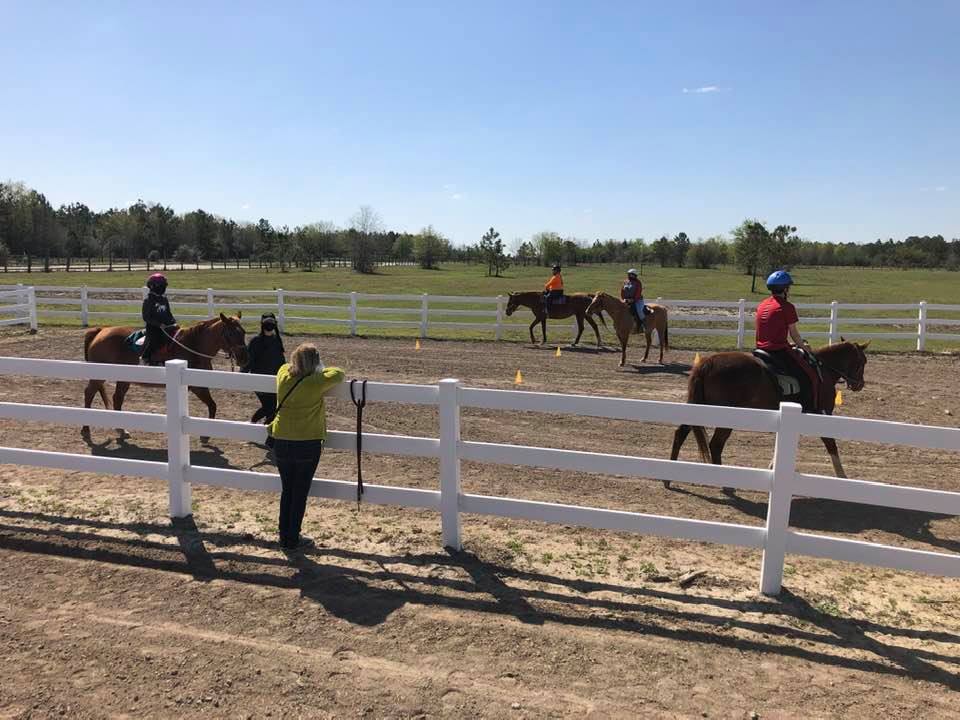
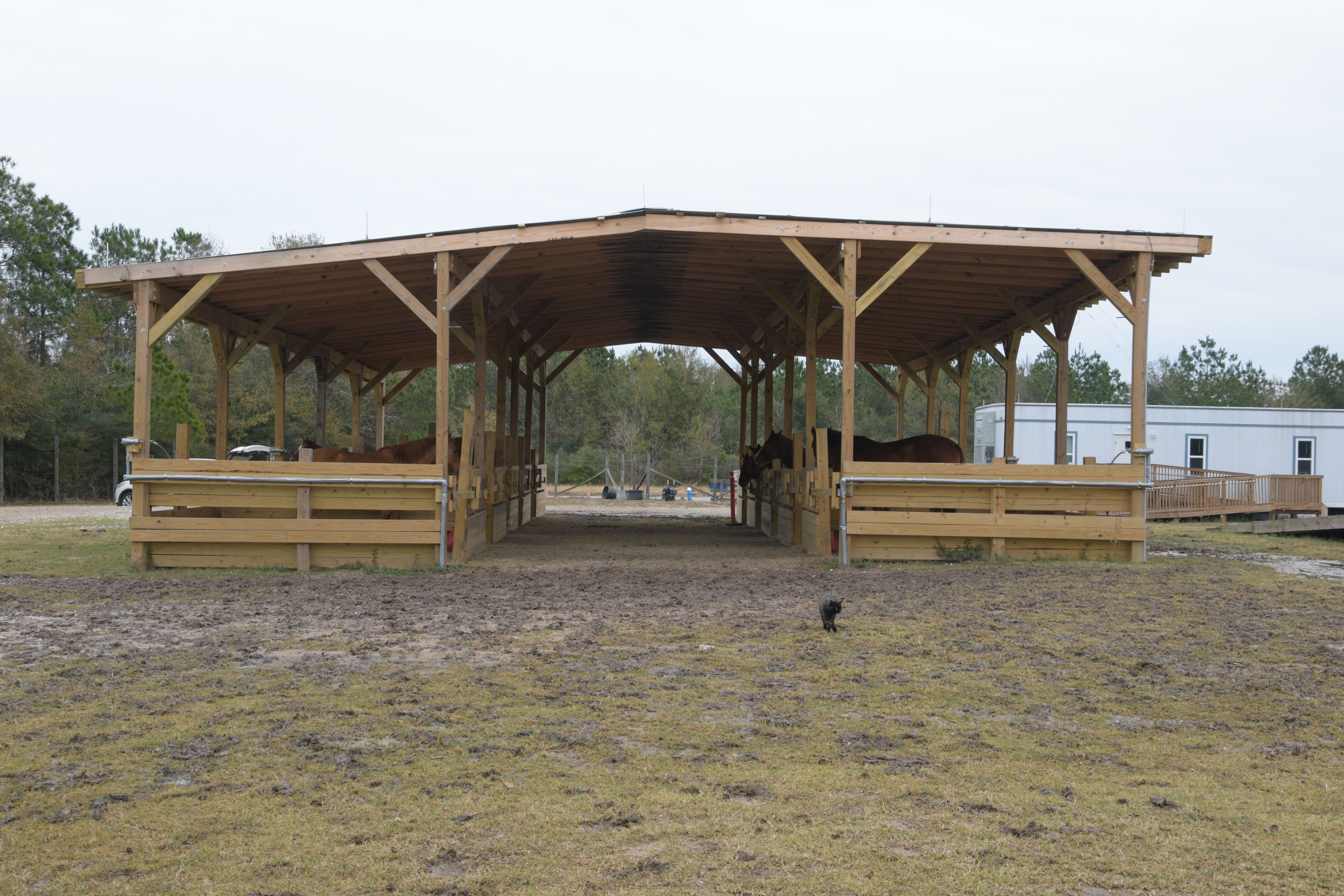
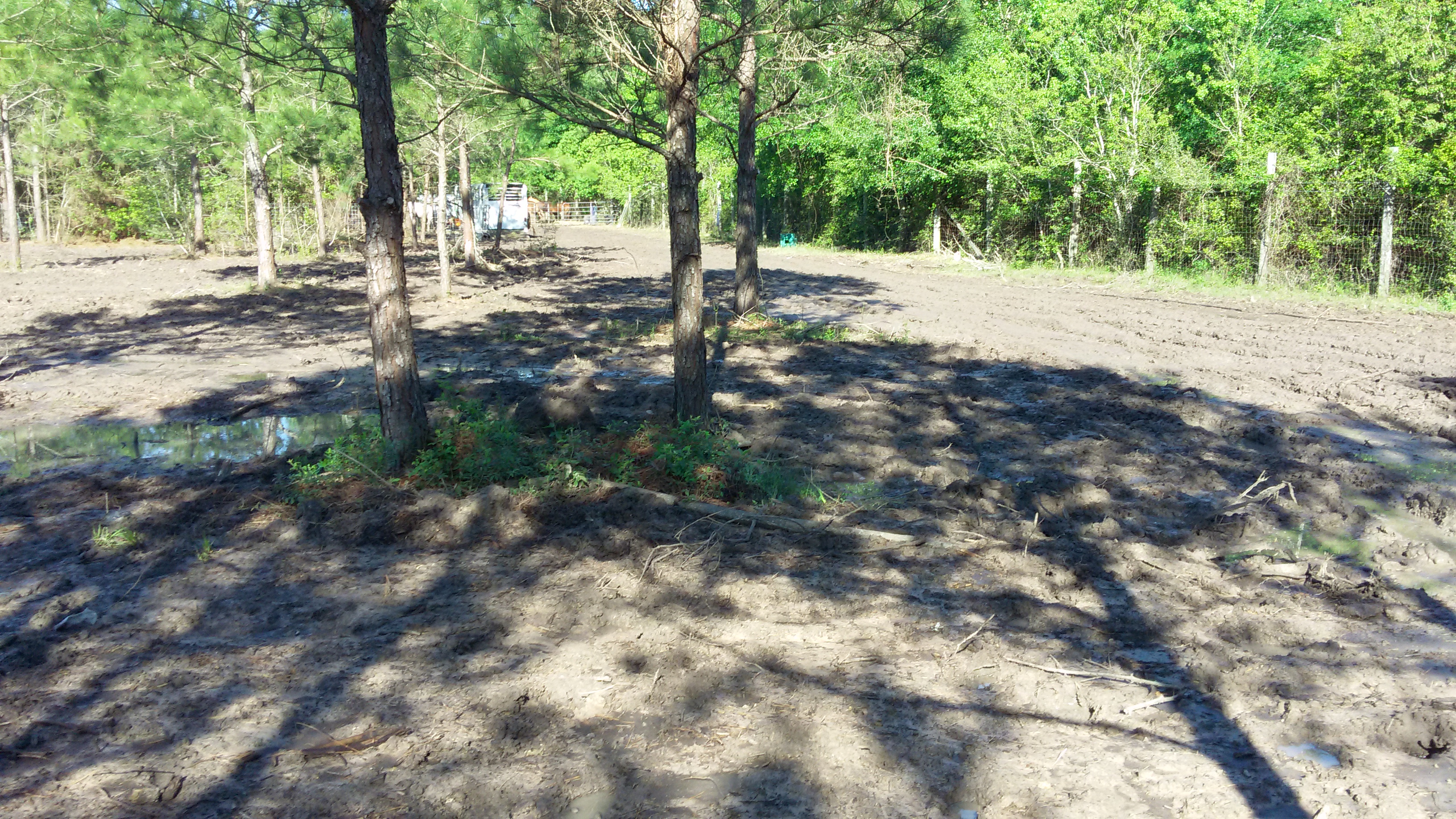
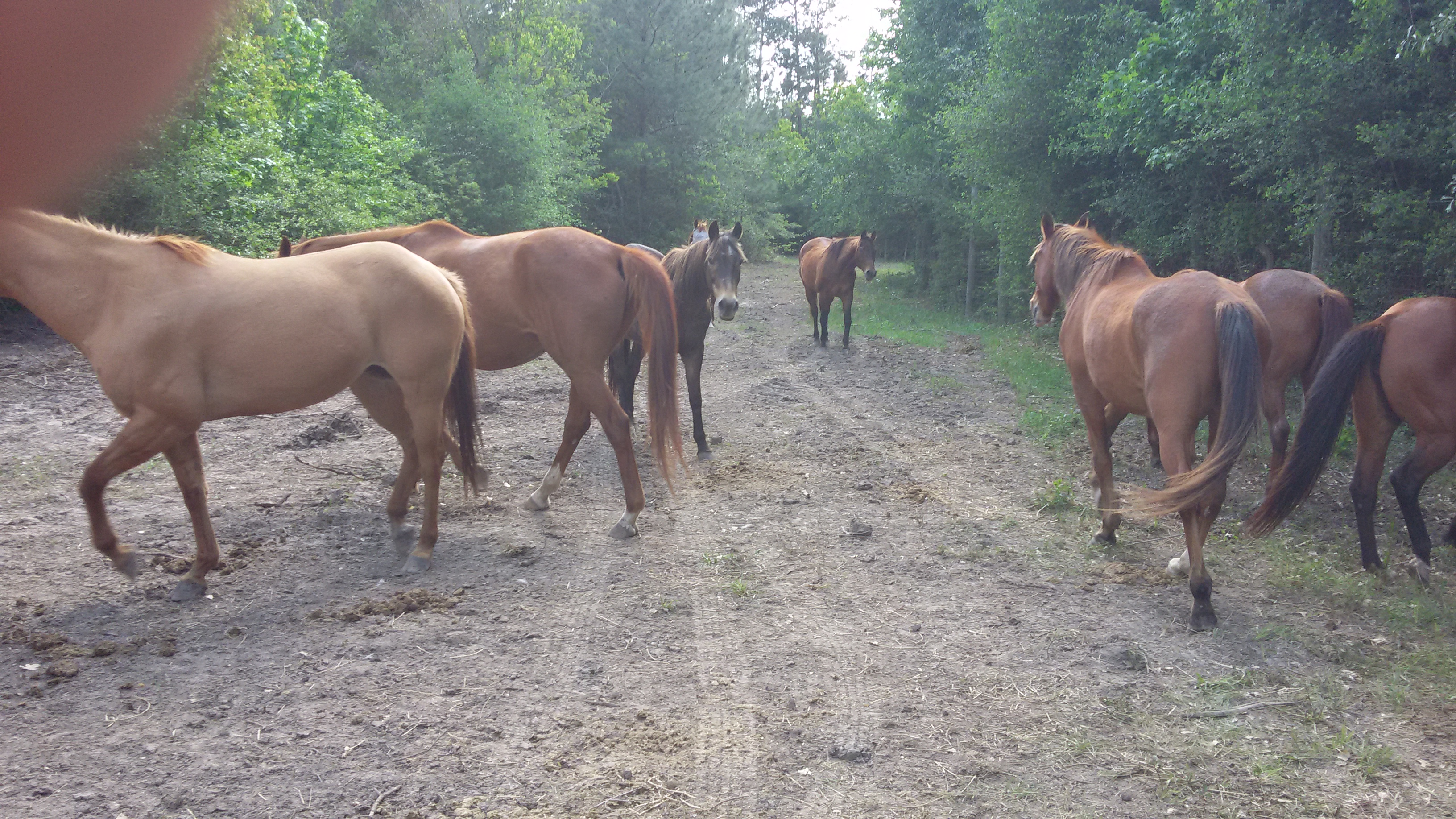
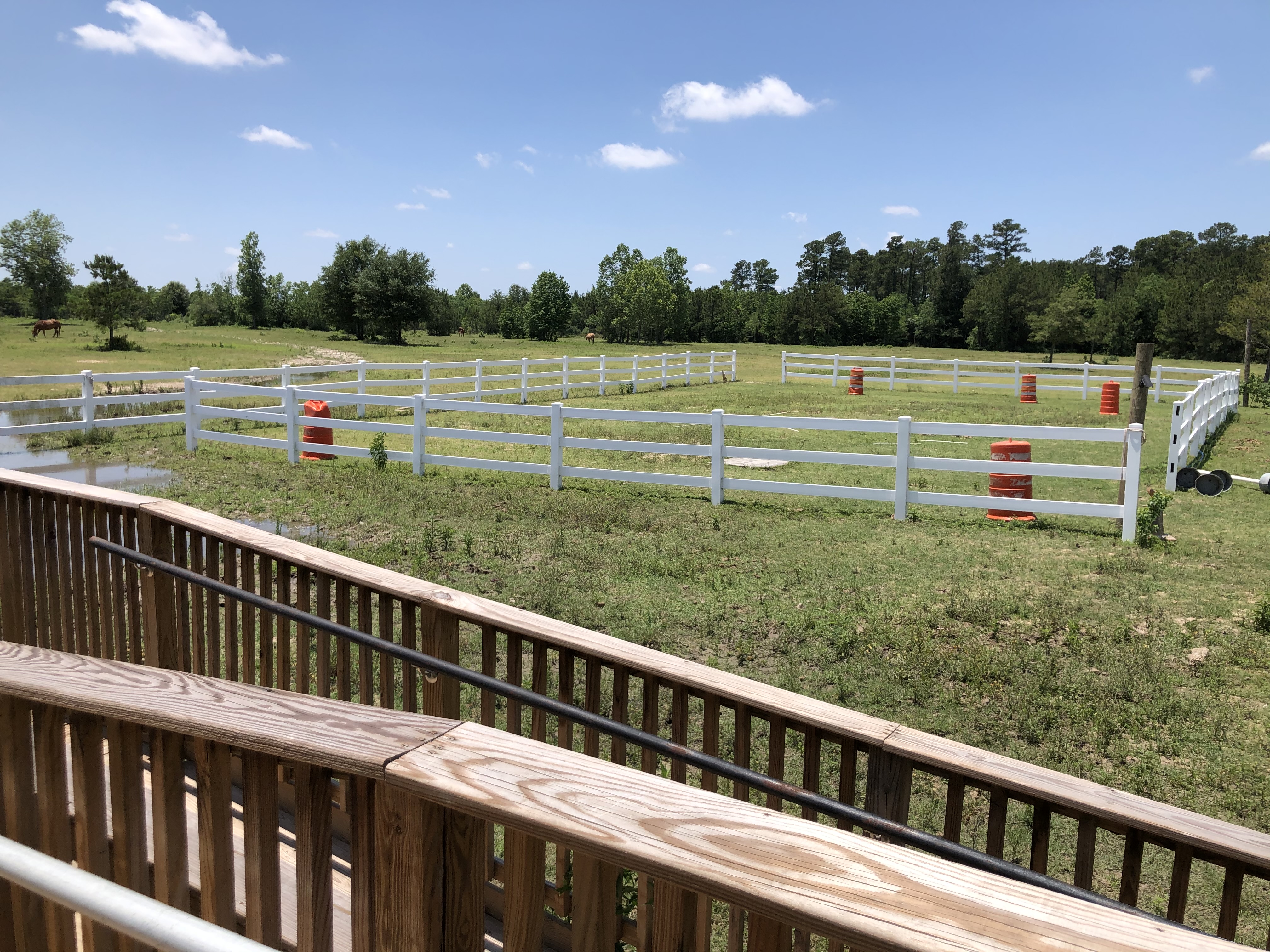
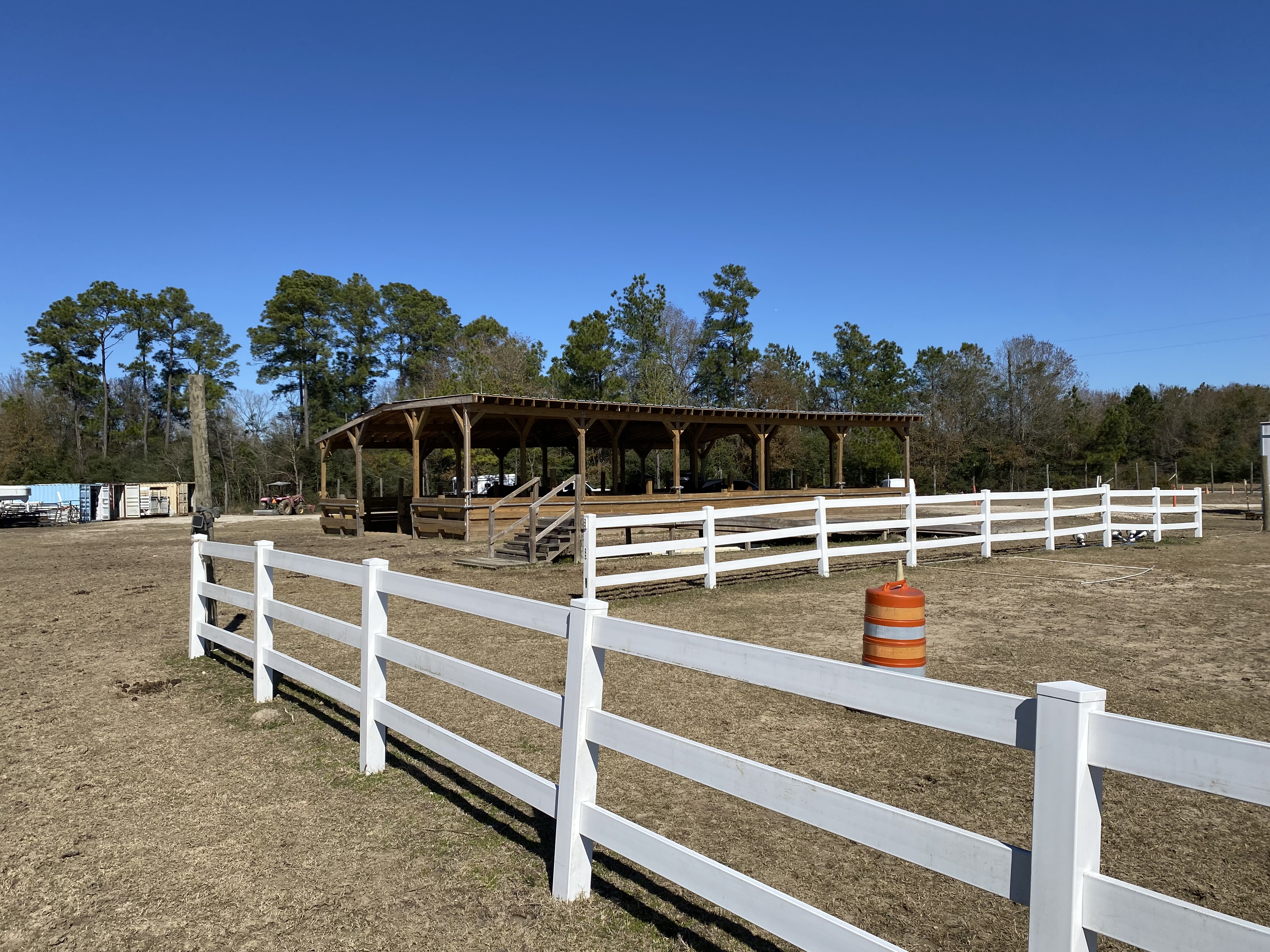
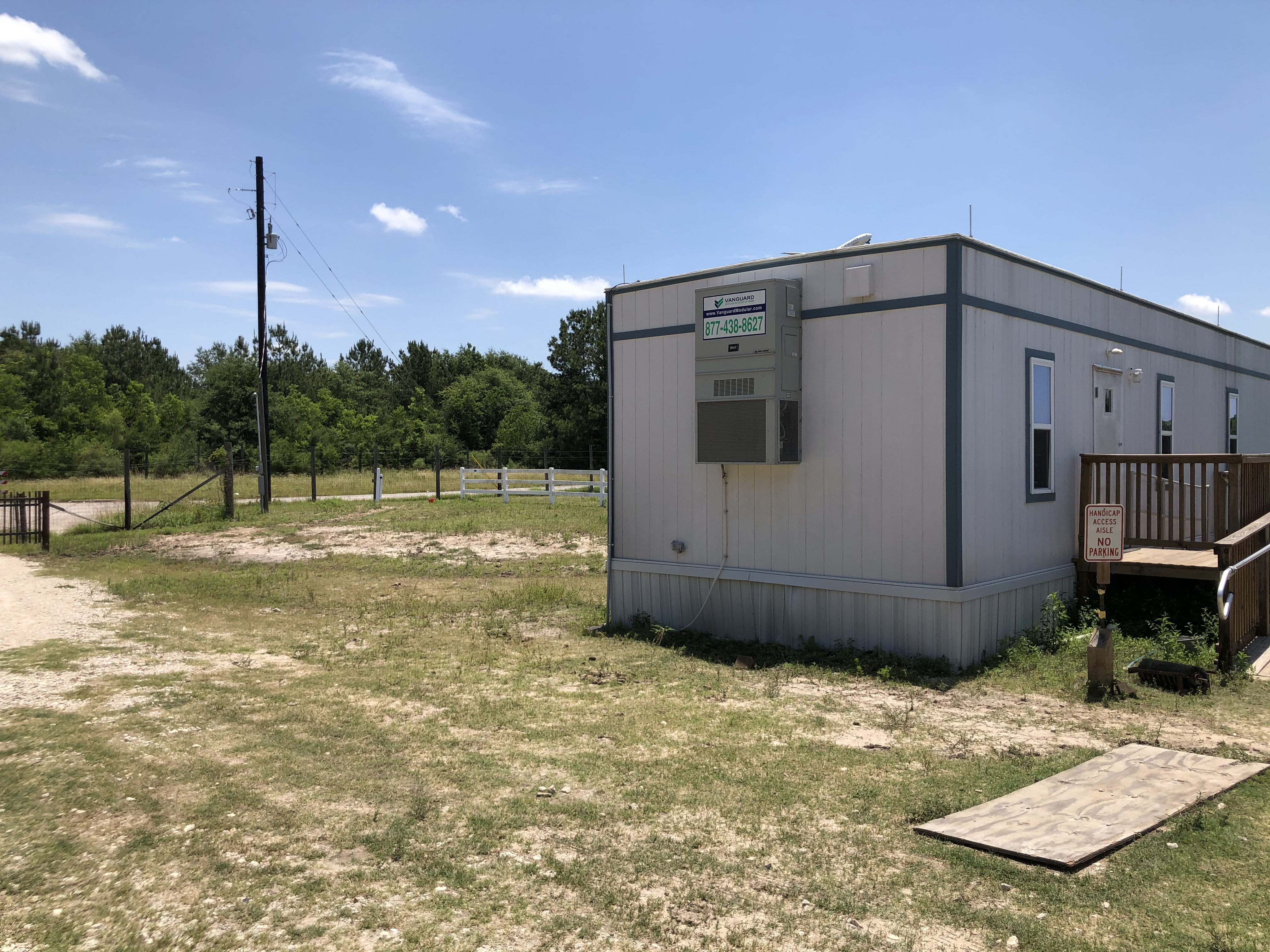
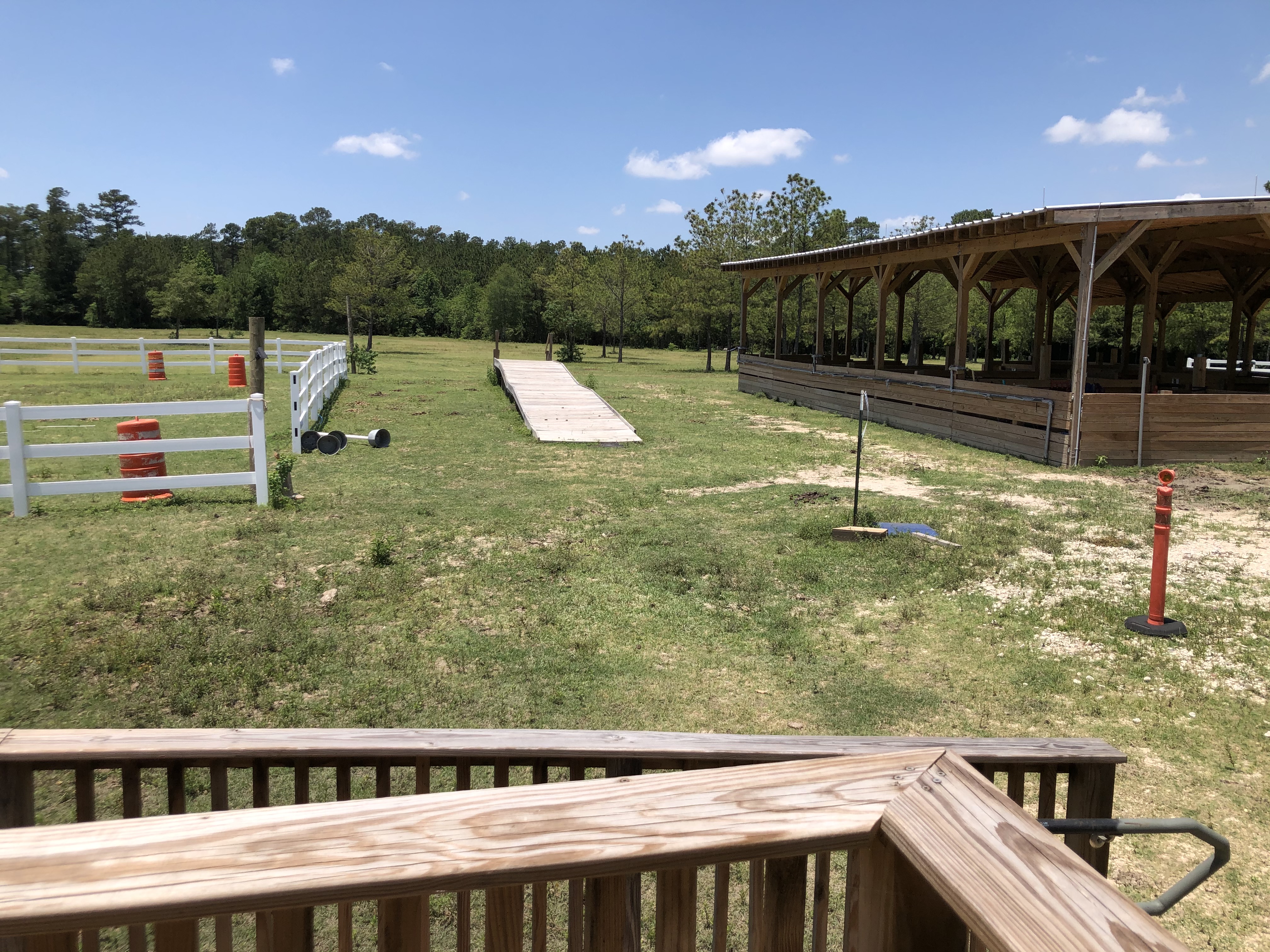
Regarding structures at this facility where horses are stalled:
Do horses have assigned stalls in the structure(s)? Yes
Do all stalls/enclosures allow horses to lie down, stand up and turn around? Yes
Is there adequate ceiling & beam height (a minimum of 12 feet above the tip of the horse's ear) when standing in all stalls/enclosures? Yes
How often are the stalls/enclosures cleaned? 6-7 Days a Week
Are floors constructed and maintained for both good drainage and traction? Yes
Is there a ventilation and circulation system in place to control temperature and prevent buildup of toxic gases? Yes
Is wiring inaccessible to horses and maintained for safety? Yes
Are fire prevention/protection measures (fire alarms, extinguishers and sprinkler systems) maintained and in good working order? Yes
Is there adequate lighting to ensure safety in all areas of facility? No
Are emergency contacts, including veterinarian contact information, conspicuously posted in easily accessible locations? Yes
Are human and equine first aid kits easily accessible? Yes
How many hours per day, on average, are horses stalled? 0-3;
How many hours per day, on average, are horses turned out:
Equines are out 16+ hours per day
Equines are out 24/7
Equines are out 24/7 except they are brought in to feed
Equines are out 24/7 except when they are being trained
Equines are out 24/7 except when they are used for the conduct of the organization's programs
The following describes the pastures at this facility:
This facility has a written plan in place for pasture management, which includes guidelines for seeding, fertilizing, irrigation, mowing, dragging, harrowing, manure removal, removal of debris, the control of poisonous plants, and a schedule for cleaning
A dedicated staff person(s) is responsible for pasture management
All pastures are fenced to prevent escape or injury
Barbed wire is used for fencing
Fencing checks, such as broken or missing planks, loose fence posts, exposed or loose nails, detached wires, etc., are done regularly
Pastures have natural protection for equines (i.e., trees)
Pastures have man-made protection for equines (i.e., shelters)
This facility does not have pastures where equines can graze on pasture grass
Electric fencing is used; electric wires or tape fence are visibly marked
Pastures are rotated
The following describes the turnout areas other than pastures at this facility:
This facility does not have turnout areas
This facility has a written plan in place for the maintenance of turnout areas, which includes a schedule for cleaning, manure removal, and dragging
A dedicated staff person(s) is responsible for the maintenance of turnout areas
All turnout areas are fenced to prevent escape or injury
Barbed wire is used for fencing
Electric fencing is used; electric wires or tape fence are visibly marked
Turnout areas have man-made protection for equines (i.e., shelters)
Fencing checks, such as broken or missing planks, loose fence posts, exposed or loose nails, detached wires, etc., are done regularly
The following policies and procedures are in place at the facility to restrict public access and to keep horses safe:
No Trespassing signs are posted
Hold Harmless signs are posted
Authorized Personnel Only signs are posted
Entrance gates are locked at night
Visitors are only permitted at specific times
Visitors are only permitted in specific areas
The property is fitted with a security system that is monitored internally by staff (or the property owner)
The perimeter of the property is fully fenced
The property owner, staff member or caretaker lives on the premises and ensures that public access is restricted and is responsible for the security of the facility and equines
A security guard is present at night
Equines are checked overnight
By Appointment Only signs are posted.
The property is fitted with motion lights
The property is fitted with a security system monitored by police or a professional service
Equine Care/Emergency Preparedness: Dream Catcher Stables (*Main) 2024 and 2023 This section is required.
Horse Health Care/Barn Management Records: What system is used to collect and store health/horse care records?
The organization utilizes its own system to maintain records
The following items are consistent with our feed management plan and practices:
Equines are provided with individualized feeding plans, including supplements, according to age and any health issues
Feed plans are determined in consultation with a veterinarian
Supplement plans are determined in consultation with a veterinarian
Equines are fed in individual stalls
Staff and volunteers are trained in proper feed measurements and protocols and observed periodically to ensure they are feeding correctly
The feed chart is centrally located and updated as needed
The area(s) where hay, feed, grain, and supplements are stored are kept clean, free of debris and chemicals, and protected from weather and other animals in rodent-proof and mold-proof containers and grain bins
Feed, supplements and hay types are clearly labeled
Water sources, i.e., buckets, troughs, automatic waterers, etc. are kept clean, free of debris and chemicals, and protected from weather and other animals
Equines are fed in groups
Medications are kept in a locked, climate-controlled area
Do horses have access to clean drinking water at all times? Yes
Hoof Care: How often is hoof care provided for each equine? Every 4-8 weeks and when an issue arises
Dental Care: How often is dental care provided for each equine? Annually and when an issue arises
Horse checks: How often are equines visually and physically checked by personnel at the facility? Every day or 6 days a week
Parasite Control: Our organization has the following worming protocols in place: (Check all that apply
A de-wormer is used without fecal testing
Fly/Insect Control: What remedies are used to control flies and insects?
Fly parasites
Fly Traps and Tapes
Premise Sprays/Insecticides
Fly Spray Repellent
Fly Masks
Fans
The following represent the biosecurity practices in place at facility:
Our organization follows the AAEP's Biosecurity Guidelines and/or the UC Davis Biosecurity Guidelines
Our organization follows the biosecurity guidelines of our veterinarian
Sick, affected and/or quarantined equines do not have contact with other equines or other animals
The organization has a written biosecurity plan
All volunteers are trained in best practices related to biosecurity
Sick, affected and/or quarantined equines are cared for last if the caretaker must also care for healthy equines
Sick, affected and/or quarantined equines do not have contact with other equines or other animals
Restricted access signs are posted at primary points of access to sick, affected and/or quarantined equines
Stalls, aisle ways, and common areas are disinfected after conclusion of the quarantine
Trailers/vans used by sick, affected and/or quarantined equines are cleaned and disinfected after each use and cleaning takes place away from where equines are sheltered
Equipment used by sick, affected and/or quarantined equines is not shared and is clearly labeled
Shared equipment used by sick, affected and/or quarantined equines is cleaned of organic debris and disinfected after each use
Latex gloves are worn when working with sick, affected and/or quarantined equines
All staff are trained in best practices related to biosecurity
A specific individual is assigned to care for sick, affected and/or quarantined equines
Hand sanitizers and footbaths are available at all primary points of access to sick, affected and/or quarantined equines
Manure and bedding from sick, affected and/or quarantined equines is disposed of in specific areas designated for infectious materials - not put in open air piles, and not spread on pastures
Personnel are required to leave the facility (or shower and change clothing) after working with quarantined equines
Equines are not quarantined on arrival.
Additional information on biosecurity:
Equines are stalled on arrival with limited contact of other equines. Should quarantine be necessary the horse will either be sent to our veterinarian for quarantine or in an emergency contained in a temporary quarantine area which we can erect in less than an hour. Horses that become ill and are infectious will be quarantined. Horses with injuries requiring stall rest will remain in their stalls with the remainder of the herd being pastured. As necessary any of our stalls can have tarpaulin or screening attached above the 4' level to create a no-contact situation.
The following represent the manure removal practices in place at facility:
Manure is piled in an area where equines are not located
Manure is hauled, sold or given away
Manure piles are composted or spread on pastures
Our organization adheres to the manure management guidelines set by state and/or local authorities
Manure is stored in dumpster(s)
Manure piles are covered
The following steps are taken to help staff and volunteers readily identify each horse on the property:
Equines are assigned the same stall/location each day
Name plates are located on the stall
Photos are located on the stall
A notebook or binder with photos and information on each equine is easily accessible
A map/diagram is posted showing the location of each equine with equine names and photos
Staff and volunteers are provided with an information packet with equine profiles, including photos and detailed descriptions
Staff/volunteers are provided training on conformation, markings, colors, and breeds
Team leaders work with new staff/volunteers until they are able to identify the equines
Equines wear halters with nametags
Equine photos and profiles are available on the website
Our organization has the following policies and procedures in place pertaining to tack, apparel and equipment:
Saddles are shared
Saddle pads are shared
Blankets, sheets and turn out apparel are fitted and utilized for each equine appropriate to the equine's needs and the weather conditions
Blankets, sheets and turn out apparel are cleaned regularly as needed
Halters are shared
Tack is cleaned only when needed
Tack is inspected for overall working condition before each use by trained personnel
Tack is assessed for fit before each use by trained personnel
Tack is assessed for fit by trained personnel when an equine's body condition changes
Assigned tack is clearly labeled
Helmets are shared
Helmets are cleaned/disinfected after each use
All equines have specifically assigned tack, apparel and equipment that is not shared
Bridles are shared
Bits are shared
Blankets are shared
Sheets are shared
Turnout apparel is shared
Tack is cleaned after each use
Tack is cleaned weekly
Tack is assessed for fit by trained personnel when an equine's disposition changes
This facility enlists the services of a professional saddle fitter at least once a year
Tack is stored in a climate-controlled location
Helmets are replaced after a fall
Helmets are replaced at least every five years.
No equines are ridden; not applicable.
Emergency Preparedness: Dream Catcher Stables: *Main This section is required.
The following plans, policies, and procedures are in place at the facility to handle emergencies and address weather related issues, fire safety procedures, and/or any additional hazardous scenarios the facility could potentially experience:
Emergency phone numbers are posted prominently
The facility owns or has access to a generator
The facility maintains at least two weeks of hay, feed, shavings and medications
The facility collects and maintains medical information from staff, volunteers, and clients
The facility maintains appropriate liability and/or workers' compensation insurance
All staff/volunteers are briefed regularly on emergency preparedness/safety procedures
The organization has a written emergency preparedness/safety plan (EPP)
Emergency procedures are posted prominently
Local fire department and/or the state's emergency planning department procedures
Medical emergencies for clients, staff, and volunteers
Medical emergencies for equines
Evacuation plans
Power outages
Fire
Natural Disasters - thunderstorm, hurricanes, earthquakes, tornados, etc
Terrorist attacks
Protocols to notify emergency personnel
Building/facility exit plans
The facility follows the specific procedures to help PREVENT emergency situations:
Smoking is strictly prohibited
NO SMOKING signs are posted prominently
Hay is stored away from permanent or temporary structures where equines are stalled
Permanent or temporary structures where equines are stalled are kept free of dust, cobwebs, trash, cleaning rags, and other flammable items
Aisles and doorways are kept clear
Heaters with automatic shutoff settings are used
How often are the following checked or performed?
Fire Extinguishers are checked: Annually
Smoke detectors are checked: Not at all/NA
Electrical Systems are checked: Not at all/NA
Fence lines are checked: Weekly
Turnout Areas are checked: Weekly
Sprinkler systems are checked: Not at all/NA
Fire drills are conducted: Not at all/NA
Review of safety protocols with staff are conducted: Not at all/NA
Review of safety protocols with volunteers are conducted: Annually
The Emergency Preparedness Plan is reviewed and updated: Annually
Equine Transportation
2-horse van/trailer with truck:
1 Owned onsite 0 Access onsite but not owned 0 Access offsite;
3-horse van/trailer with truck:
0 Owned onsite 0 Access onsite but not owned 0 Access offsite;
4-horse van/trailer with truck:
0 Owned onsite 0 Access onsite but not owned 0 Access offsite;
6-horse van/trailer with truck:
0 Owned onsite 0 Access onsite but not owned 0 Access offsite;
8-horse van/trailer with truck:
1 Owned onsite 0 Access onsite but not owned 0 Access offsite;
10-horse van/trailer with truck:
0 Owned onsite 0 Access onsite but not owned 0 Access offsite;